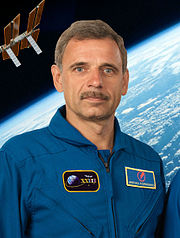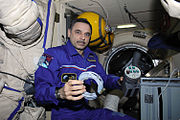| Mikhail Korniyenko | |
|---|---|
 | |
| Born | April 15, 1960 |
| Place of birth | Syzran, Kuibyshev (Samara) Region, Russia |
Mikhail Borisovich Korniyenko (Михаил Борисович Корниенко; born April 15, 1960) is a Russian cosmonaut.
Personal life[]
Korniyenko was born in Syzran, Kuybyshev Oblast, Russian SFSR. He is married to Irina Kornienko, a physician. They have a grown daughter. His father, Boris G. Kornienko, a military pilot, perished in an airplane crash in 1965. His mother, Faina M. Kornienko born in 1931 is retired.[1]
Education[]
Korniyenko graduated from secondary school No. 15, Chelyabinsk; Russia, in 1977. From 1981 to 1987 he studied at the Moscow Aviation Institute named after S. Ordzhonikidze.
Military career and experience[]
Upon graduation from school in 1977, he worked at a radio equipment plant in Chelyabinsk, Russia. In May 1978, Korniyenko was called to service in the Soviet Army. He served in the paratrooper forces in Kirovobad, Azerbaidzhan, the USSR. In May 1980, he completed his military service with the rank of a junior sergeant. Kornienko worked for the Moscow Militia from 1980–1986. At the same time he attended the evening Department of Moscow Aviation Institute. Upon graduation in 1987 from the institute, he was qualified as a liquid propellant rocket engines mechanical engineer. He resigned from the Militia in 1986 and entered a mechanical engineering design bureau. During 1986 to 1991 Korniyenko worked in the Baikonur Launch Facility as a launch equipment specialist.
He worked for commercial companies between late 1991 to early 1995. From October 1991 to December 1992 he was the OOO Transvostok Technical and Production Department Director. From January 1993 to April 1995 he was the LLC ESTE General Director. In October 1995, Kornienko started working at the Energia Rocket/Space Corporation (RSC) as an engineer. He was assigned with developing technical documentation for cosmonaut primary and backup crew tests and training. He took part in EVA tests in simulated zero-gravity at the hydrolab and at the Selen dynamic stand. In the process of this work he acquired experience in organizing extravehicular repair/refurbishment and assembly activities on the Mir orbital station. He also directly participated in testing the Energia RSC production on the testing ground.
Cosmonaut career[]

Mikhail Kornienko near floating tomatoes in the Unity Node of the ISS.
On February 24, 1998, Kornienko was selected as a test cosmonaut candidate[2] and, in 1991, following basic training at the Yu. Gagarin Cosmonaut Training Center, he was qualified as a test cosmonaut. Since 1999, he has trained in the International Space Station group. He served on the ISS Expedition 8 backup crew as a flight engineer.
In 2005, he was assigned to the Soyuz TMA-10 and Expedition 15 back-up crew as Flight Engineer 1.
Expedition 23/24[]

Kornienko services the Russian Bioemulsion experiment in the Pirs Docking Compartment.
Kornienko was aboard the space station as a Flight Engineer, being part of the Expedition 23/ crew. He lifted off on April 2, 2010, along with fellow Russian cosmonaut Aleksandr Skvortsov and NASA astronaut Tracy Caldwell-Dyson aboard Soyuz TMA-18 from the Baikonur Cosmodrome.[3]
Ending Expedition 24, the Soyuz TMA-18 spacecraft carrying Mikhail Kornienko, Alexander Skvortsov and NASA astronaut Tracy Caldwell-Dyson undocked from the space station at 10:02 pm EDT on September 24, 2010. Following a normal descent, the Soyuz crew landed at 5:23 am GMT ear Arkalyk, Kazakhstan on September 25.
After returning to Earth and sharing his experiences to an audience, Kornienko said "The thing you miss there most of all is the Earth itself, I missed smells. I missed trees, I even dreamt of them. I even hallucinated. I thought I smelled a real fire and something being barbecued on it! I ended up putting pictures of trees on the walls to cheer up. You do miss the Earth there".[4]
Spacewalks[]
On July 27, 2010 Kornienko and fellow Russian cosmonaut Fyodor Yurchikhin participated in a spacewalk outside the ISS. The two cosmonauts on July 23 put on their Orlan spacesuits and performed a dry run of the spacewalk activities. From inside the Pirs docking compartment they checked out the Orlan systems, practiced translation movements and tested their mobility. During the spacewalk, Kornienko and Yurchikhin outfitted the Rassvet module's (MRM1) Kurs automated rendezvous system, installed cables and remove and replaced a video camera.[5] The spacewalk began at 04:11 UTC as Kornienko and Yurchikhin donned in Orlan spacesuits, depressurized the internal volume of the Pirs docking compartment airlock and ventured outside into space. It was the 25th Russian spacewalk performed from the station.[6] At one point around 06:45 UTC the two spacewalkers accidentally lost an unidentified object that floated away from their perch on the side of the ISS.[7] The cosmonauts speculated that the lost item was an attachment fixture to secure the cables in place once they are installed. About an hour later, another unidentified item, appeared to be a washer accidentally floated off. The spacewalk lasted six hours and 42 minutes.
Year Long Mission[]
In November, 2012, NASA, the Russian Federal Space Agency (Roscosmos), and their international partners have selected two veteran spacefarers for a one-year mission aboard the International Space Station in 2015. This mission will include collecting scientific data important to future human exploration of our solar system. NASA has selected Scott Kelly and Roscosmos has chosen Mikhail Korniyenko. Kelly and Kornienko will launch aboard a Russian Soyuz spacecraft from the Baikonur Cosmodrome in Kazakhstan in spring 2015 and will land in Kazakhstan in spring 2016. Kelly and Kornienko already have a connection; Kelly was a backup crew member for the station's Expedition 23/ crews, where Kornienko served as a flight engineer. The goal of their yearlong expedition aboard the orbiting laboratory is to understand better how the human body reacts and adapts to the harsh environment of space. Data from the 12-month expedition will help inform current assessments of crew performance and health and will determine better and validate countermeasures to reduce the risks associated with future exploration as NASA plans for missions around the moon, an asteroid and ultimately Mars.[8]
References[]
This article incorporates public domain material from websites or documents of the National Aeronautics and Space Administration.
- ↑ NASA (November 2006). "Biographical Data:Mikhail Borisovich Kornienko". http://www.jsc.nasa.gov/Bios/htmlbios/kornienko.html. Retrieved March 19, 2010.
- ↑ ENERGIA RSC (March 2007). "Mikhail B. Kornienko". http://www.energia.ru/eng/iss/iss15/kornienko.html. Retrieved March 19, 2010.
- ↑ William Harwood (April 2, 2010). "Soyuz crew transport capsule heads for space station". Spaceflight Now. http://spaceflightnow.com/station/exp23/100402launch.html. Retrieved June 3, 2010.
- ↑ Russian Federal Space Agency (2010-09-28). "Soyuz TMA-18 Cosmonauts Share Some Experiences from Space". http://www.federalspace.ru/main.php?id=2&nid=10438. Retrieved 2010-10-17.
- ↑ NASA (July 21, 2010). "Expedition 24 Spacewalk Briefing". http://www.nasa.gov/mission_pages/station/expeditions/expedition24/eva_briefing_072110.html. Retrieved July 24, 2010.
- ↑ Clara Moskowitz (July 27, 2010). "Despite Losing Tools, Cosmonauts Complete Spacewalk". SPACE.com. http://www.space.com/missionlaunches/cosmonauts-spacewalk-space-station-lost-tool-100727.html. Retrieved July 28, 2010.
- ↑ Justin Ray (July 27, 2010). "Spacewalkers complete overnight excursion". Spaceflight Now. http://www.spaceflightnow.com/station/exp24/100727eva/. Retrieved July 28, 2010.
- ↑ "NASA, Roscosmos Assign Veteran Crew to Yearlong Space Station Mission". NASA. November 26, 2012. http://www.nasa.gov/home/hqnews/2012/nov/HQ_12-406_ISS_1-Year_Crew.html. Retrieved 2012-11-26.
External links[]
The original article can be found at Mikhail Korniyenko and the edit history here.